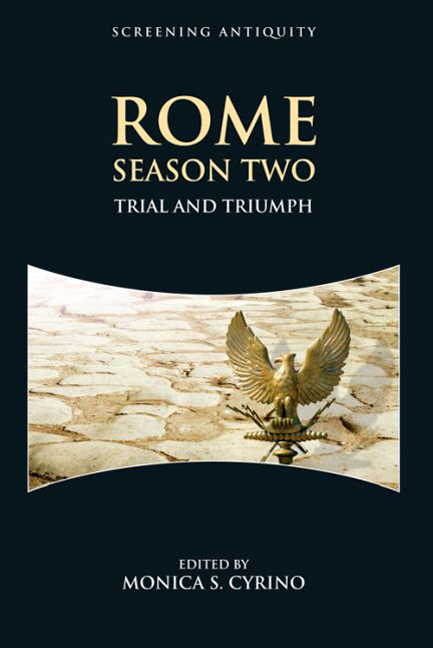Book contents
- Frontmatter
- Contents
- Series Editors’ Preface
- Editor's Acknowledgments
- Contributors
- List of Illustrations
- Episode Listing
- Cast List
- Introduction: The Trials and Triumphs of Rome, Season Two
- PART I POWER AND POLITICS
- PART II Sex and Status
- 8 Revenge and Rivalry in Rome
- 9 Effigies of Atia and Servilia: Effacing the Female Body in Rome
- 10 Livia, Sadomasochism, and the Anti-Augustan Tradition in Rome
- 11 Windows and Mirrors: Illuminating the Invisible Women of Rome
- 12 Antony and Atia: Tragic Romance in Rome
- 13 Problematic Masculinity: Antony and the Political Sphere in Rome
- 14 Rome, Shakespeare, and the Dynamics of the Cleopatra Reception
- 15 The Rattle of the Sistrum: “Othering” Cleopatra and Egypt in Rome
- 16 Gateways to Vice: Drugs and Sex in Rome
- 17 Slashing Rome: Season Two Rewritten in Online Fanfiction
- Filmography
- Bibliography
- Index
11 - Windows and Mirrors: Illuminating the Invisible Women of Rome
from PART II - Sex and Status
Published online by Cambridge University Press: 07 October 2017
- Frontmatter
- Contents
- Series Editors’ Preface
- Editor's Acknowledgments
- Contributors
- List of Illustrations
- Episode Listing
- Cast List
- Introduction: The Trials and Triumphs of Rome, Season Two
- PART I POWER AND POLITICS
- PART II Sex and Status
- 8 Revenge and Rivalry in Rome
- 9 Effigies of Atia and Servilia: Effacing the Female Body in Rome
- 10 Livia, Sadomasochism, and the Anti-Augustan Tradition in Rome
- 11 Windows and Mirrors: Illuminating the Invisible Women of Rome
- 12 Antony and Atia: Tragic Romance in Rome
- 13 Problematic Masculinity: Antony and the Political Sphere in Rome
- 14 Rome, Shakespeare, and the Dynamics of the Cleopatra Reception
- 15 The Rattle of the Sistrum: “Othering” Cleopatra and Egypt in Rome
- 16 Gateways to Vice: Drugs and Sex in Rome
- 17 Slashing Rome: Season Two Rewritten in Online Fanfiction
- Filmography
- Bibliography
- Index
Summary
When they were concerned with women at all, Roman historians focused almost exclusively on imperial women or other elites, so that those outside the highest levels of the aristocracy remain virtually invisible to history. Cinematic depictions of the Roman world, in contrast, have shown an interest in the lower classes, both men and women, but they typically adhere to the common stereotype of a virtuous and industrious lower class set against a corrupt, vice-ridden elite. The Rome series largely avoids these pitfalls1 by not only acknowledging the diverse roles of non-elite women in antiquity, but also providing these female characters with individuality and complexity. Admittedly, the portrayal of women like Eirene, Gaia, and Vorena in Rome's second season does replicate some ancient prejudices about the female nature that have become familiar components of modern depictions: women are scheming, duplicitous, and dangerous, both sexually and otherwise. The men of Rome, in addition, seem to impose on these women the familiar “goddess/whore” dichotomy prevalent in ancient literary accounts of their upper-class sisters. But while the series repeats some of these biases, it also takes pains to trouble them, revealing such binary divisions to be a function of individual male subjectivity and exposing the “Catch-22” nature of the dilemma whereby women who would exert agency were limited to channels that required them to enact the very traits used to justify controls on their behavior. The series thus demonstrates that in a world where they are largely disenfranchised, women must draw on the tools at their disposal – such as their sexuality and reproductive functions – to negotiate power and position. The non-elite women of Rome in Season Two thus provide an instructive complement to the historically attested elite female characters, offering both a window into the lives of women in ancient Rome and a mirror in which we might catch reflections of ancient biases about the nature of women lingering in contemporary narratives.
THE WOMEN OF ROME
Through its lower-class female characters, Rome's second season suggests to its viewers many important social realities for women, such as their association with domestic duties and nurturing roles. In this series, lower-class women cook, clean, and care for the sick, and thus they hint at the ancient association of women with “inside” and men with “outside.”
- Type
- Chapter
- Information
- Rome Season TwoTrial and Triumph, pp. 141 - 154Publisher: Edinburgh University PressPrint publication year: 2015

